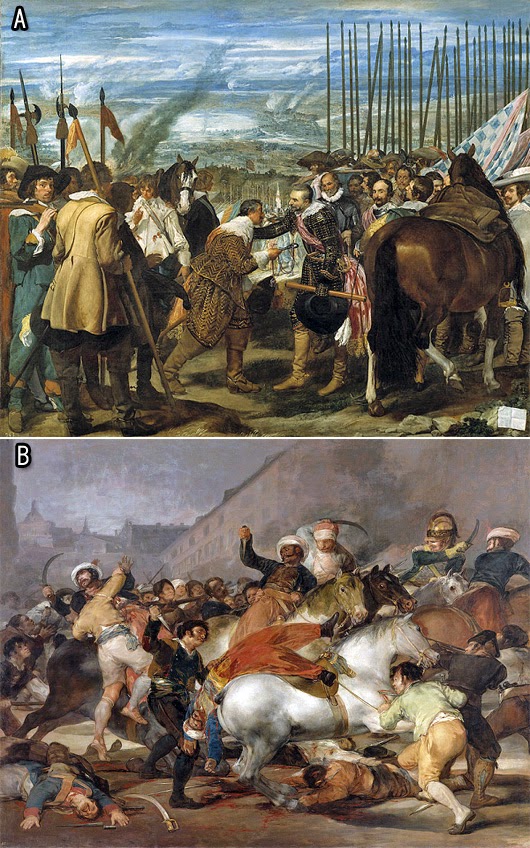スペインとポルトガルを巡る旅 38: プラド美術館
< 1. “Las Meninas”
by Velázquez,
1656, the family of King Philip
IV >
< 1. ベラスケス作「女官たち」、1656年、フェリぺ4世の家族 >
Today, I introduce Prado Museum in
Madrid that has one of the largest collections as pictorial arts in Europe.
When there is not a mention of the possession, it is all a thing of
Prado Museum.
今日は、絵画ではヨーロッパ屈指の収集を誇るスペイン、マドリードにある国立美術館を紹介します。
所蔵の記載が無い場合はすべてプラド美術館のものです。
< 2. A exhibit room,
the structural drawing and the cafeteria in Prado Museum >
< 2. 絵画展示室、プラド美術館の構造図、カフェテリア >
Prado Museum
In it, there are main European
arts that were drawn from the 16 century of last Renaissance era to the 18
century.
The works cover three
major Spanish painters (El Greco, Velázquez, Goya), and all painters of the
Middle Ages of Spain.
There are many works of
Venetian School (Italy) and Flemish school (France), too.
The works were collected by the
kings of a great empire that was known as “the empire on which the sun never
sets”.
The works of 500 painters is about 8,000
in here.
Of those, works of Goya is 182, Greco is
49, Velázquez is 133, and Rubens is 110.
There are also about 1000 sculptures.
プラド美術館
16世紀のルネサンス末期から18世紀にいたるヨーロッパの主要流派の作品が網羅されている。
作品はスペインの三大画家エル・グレコ、ベラスケス、ゴヤと中世画家を網羅し、ベネチア派(イタリア)とフランドル派(フランス)も多い。
作品は、「太陽の沈まない国」と称された大帝国の王達により収拾された。
500人の画家の作品が約8000点あり、内ゴヤ182点、グレコ49点、ベラスケス133点、ルーベンス110点ある。
( 注1.画家の作品数は「MUSEO NACIONAL DEL PRADO」の「On-line
gallery」で検索した数)
彫刻も約1000点ある。
Advice for observing
Within three hours, it
is impossible to hear the commentary of major works, to take a lunch, and then
to observe all other works at free time.
I saw nearly all
pictures at a fast walk.
Because there are very many exhibition
rooms, you beforehand decide some painters, and should check these rooms.
I passed through the same room many
times because it was like a maze.
I like the cafeteria of
ground floor in the above photograph.
見学へのアドバイス
3時間で主要作品の解説を聞き、カフェテリアで昼食、自由見学ですべてを鑑賞するのは無理です。
私は早足で絵画を一応見ました。
非常に展示室が多いので、予め見たい画家を決めて部屋を調べておくのがよいでしょう。
迷路のようになっている為、私は同じ部屋を幾度も通り過ぎてしまった。
写真にある一階のカフェテリアは気に入りました。
< 3. Comparison of war pictures >
< 3. 戦争画の比較 >
A: “The Surrender
of Brenda” by Velázquez,
1634-1635.
This picture is one
scene of the fight of Netherlands in 1625.
B: “The Second of May 1808” by Goya, 1814.
This picture is a fight of Napoleon’s army and Madrid citizen.
Two pictures have the
difference between 200 years, but even so there is big difference about the
role of the fight and the expression.
A: ベラスケス作「ブレダの開場」1634―1635年。作品は1625年のネーデルラントの戦い。
B: ゴヤ作「1808年5月2日、エジプト人親衛隊との戦闘」1814年。
本作はナポレオン軍とマドリッド市民の戦い。
二つの絵には200年の年月の開きがありますが、戦いの主役と表情に大きな違いがあります。
< 4. Comparison of the pictures of “Immaculate Conception” >
< 4.「無原罪の御宿り」を主題にした絵画を見比べる >
“Immaculate Conception” is a conception of the
Blessed Virgin Mary to have been free from original sin in the teaching of the
Catholic Church.
Every themes of religious painting had
many rules expect the words of the Bible.
For this, it is the custom to describe a
12-13 years old girl, standing with her back against the sun, stepping on the
moon (and a snake also), wearing a crown of 12 stars, and wearing a blue mantle
over a white clothe.
C: by El Greco, 1607 -
1613, Santa Cruz Museum, Toledo.
D: by Velázquez,
1618, National Gallery, London.
E: by Rubens, 1626 -
1628.
「無原罪の御宿り」とはカソリックの教義で、聖母マリアには原罪や汚れがないことを意味する。
宗教画の主題には、聖書による文言以外に多くの決まりがありました。
これには、12から13才の少女が太陽を背に受けて、足は月を踏み(蛇も)、頭には12の星の冠、白い着物の上に青いマントを着けることが慣わしでした。
C: エル・グレコ作、1607―1613年、Santa Cruz Museum, Toledo。
D: ベラスケス作、1618年、National Gallery, London。
E: ルーベンス作、1626-1628年。
< 5. Comparison of the pictures of “Immaculate Conception” >
< 5.「無原罪の御宿り」を主題にした絵画を見比べる >
F: by Zurbarán, 1630. He was a Spanish painter in Sevilla.
G: by Murillo, 1678. He was a Spanish painter in Sevilla.
H: by Goya, 1784. Ln
this time, he became a court painter and 38 years old.
I think that I saw
nearly 20 pictures of “Immaculate Conception” in Prado.
Among above 6 pictures, I liked
unconventional Greco, Rubens painting ample feminine beauty, and Murillo
painting nectarous beauty.
F: スルバラン作、1630年。彼はセビージャで活躍したスペイン画家。
G: ムリーリョ作、1678年。彼もセビージャで活躍したスペイン画家。
H: ゴヤ作、1784年。彼はこの時38才で宮廷画家になっていた。
私はプラドで「無原罪の御宿り」を20点近く見たと思います。
( 注1.「MUSEO NACIONAL DEL PRADO」の「On-line
gallery」で検索した数は38点 )
私は上記6枚では、型破りなグレコ、ふくよかな女性美のルーベンス、甘美なムリーリョが印象的でした。
< 6. My favorite >
< 6. 私のお気に入り >
H: “Equestrian Portrait of Charles V” by
Tiziano, 1548.
He was a painter
representing the Renaissance of Venice in Italy, and El Greco was affected by
him.
Charles V was a king of Habsburg Empire
in the heyday that possessed Spain, Central and East Europe, and also was Holy
Roman Emperor.
I: “Doña Juana
La Loca “ by Ortiz, 1877.
A lady dressed in black standing in the
center is the Juana of Castile and mother of Charles V.
She went mad with abrupt death of her
husband after a political marriage, and continued wandering around wasteland
for several years without his burial.
The sorrow painfully came down to me from the big screen of 5m in
width.
J: “The Triumph of Death” by Pieter Bruegel, 1562.
I liked his pictures of living of farmers from before, and I could see accidentally.
I was surprised that it was small than
size of my supposing.
Introduction of
Spanish art ended in this.
H: ティツィアーノ作「カール5世騎馬像」、1548年。
彼はベネチアのイタリアルネサンスを代表する画家で、エル・グレコは彼の影響を受けている。
カール5世はスペインと中・東欧を領有するハプスブルク帝国の全盛期の王、かつ神聖ローマ皇帝であった。
I:オーティス作「狂女王フアナ」、1877年。Francisco
Pradilla Ortiz
真ん中に立つ喪服姿がファナ王女(カスティーリャ王国)で、カール5世の母です。
彼女は政略結婚の末、夫の突然死に発狂し、彼の埋葬を許さず、荒野を数年間さまよい続けた。
4mX5mの大画面からその悲しみが痛いほど伝わってくる。
J: ピーテル・ブリューゲル作「死の勝利」、1562年。
私は以前から彼の農民生活の絵が好きでしたが、偶然、見ることが出来ました。
大きさが117X162cmと思ったより小さいのに驚きました。
これでスペイン芸術の紹介は終わりました。




























